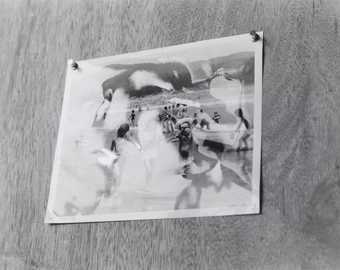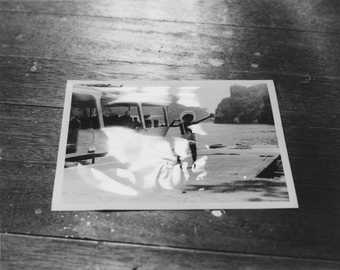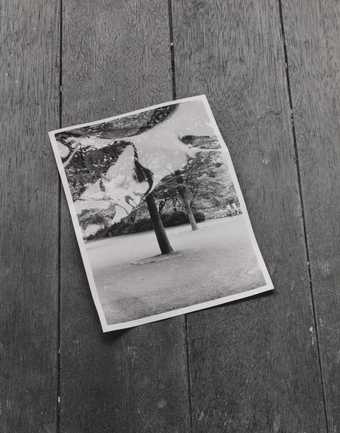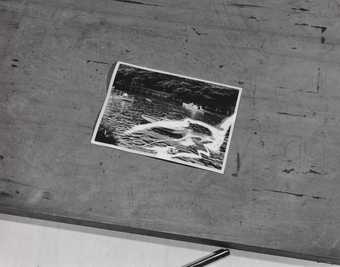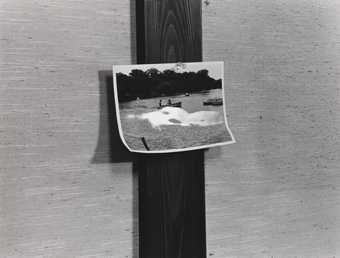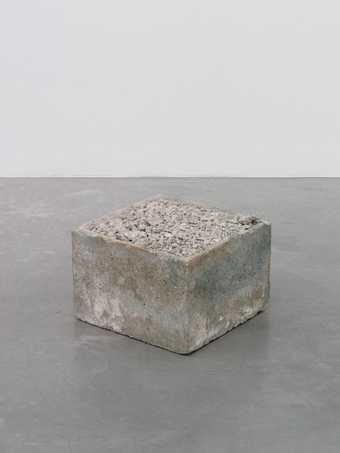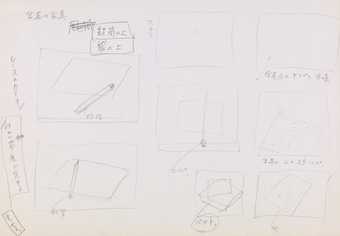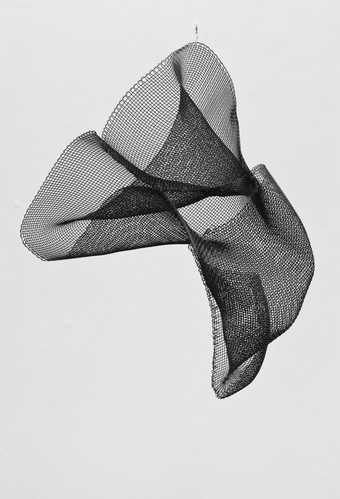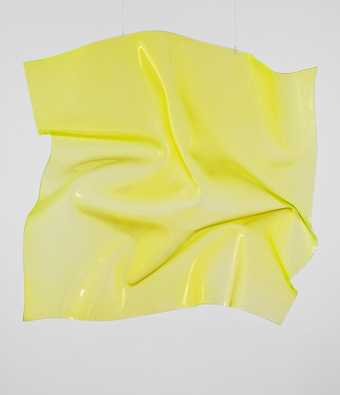In Tate Modern
- Artist
- Jiro Takamatsu 1936–1998
- Medium
- Cedar
- Dimensions
- Object: 1312 × 295 × 320 mm
- Collection
- Tate
- Acquisition
- Purchased with funds provided by the Asia-Pacific Acquisitions Committee 2011
- Reference
- T13498
Summary
Oneness of Cedar 1970 is made from a single cedar log, the top two-thirds of which have been carved so that a straight, evenly planed ‘plank’ of wood emerges from the centre of the natural trunk below. The artist has described the genesis of the work:
One day, I was at a bus stop looking at the rugged trunk of a roadside tree for quite some time. I began to think that inside that tree, there must also exist a square pillar, the surface of which could be planed smoothed like the pillars that were used to build my house … Scientists seem to think about the relationships that exist between objects, but in my case (and in the case of many other artists), I think about the relationships between objects and myself. It can’t be helped that the scale of my subjects is smaller than that of scientists.
(Jiro Takamatsu, Quest for Absence, Tokyo 2003, pp.246–7, quoted in Fuchu Art Museum 2004, p.76.)
This work belongs to Takamatsu’s Oneness series made between 1969 and 1972. With this body of work, the artist explored the complexity and resonances of individual materials. For each Oneness piece he used a familiar, everyday substance such as wood or concrete (see Oneness of Concrete 1970, Tate T13499). The series includes seven other versions of Oneness of Cedar, all of which are unique and of different sizes. Four of these are in the collection of the Toyota Municipal Museum of Art, Toyota City, while the other three are in the collections of the Church of Perfect Liberty, Osaka, a private collection in Japan and the estate of the artist. In addition the series includes works made in other materials such as concrete, iron, brick, granite and paper. Each work in the series was formed using a similar methodology. Takamatsu chose a single material and manipulated it, demonstrating its intrinsic transformative potential as well as its singularity. For Takamatsu this artistic gesture has a metaphorical and philosophical implication, suggesting the uniqueness and mutability of self-identity.
In focusing the audience’s attention on different aspects or qualities of a given material, these works hint at the complexity of the most simple, everyday objects. Takamatsu’s contribution to the seminal Tokyo Biennale exhibition of 1970 Between Man and Matter included a range of works from the Oneness series. He also contributed a text to the exhibition catalogue in which he wrote:
It seems that there is always great uncertainty in our being concerned only with particular (partial) elements of a matter. I think therefore it is necessary to have more total relation to a matter within the range of our own capacity. Sometimes such relation arises merely from our being aware of a matter and hardly with any effort, but for most occasions some action is required. To me this action is artistic creation.
(Jiro Takamatsu, ‘Comment’, in Tokyo Metropolitan Art Museum 1970, unpaginated.)
Oneness of Cedar resonates with the tree sculptures that the Italian arte povera artist Giuseppe Penone began making at the same time (see Penone’s Tree of 12 Metres 1980–2, Tate T05557). Takamatsu’s first Oneness of Cedar piece dates from 1969, the same year as Penone’s first tree sculpture. However, whereas Penone carved into industrial sawn timber planks to reveal the shape of trees within them, Takamatsu conversely exposed the industrial material lying dormant within the natural contours of tree trunks. This can be read as Takamatsu’s comment on the new approach to objects that resulted from the rapid industrialisation in Japan in the post-war period. At a time when, particularly in urban centres like Tokyo, traditional relationships to the natural world were overtaken by the expansive development of consumer culture.
Takamatsu began his career in 1963 as one of the founding members – with Genpei Akasegawa and Natsuyuki Nakanishi – of the performance collective Hi Red Center, which staged provocative dada-inspired actions on the streets of Tokyo that were intended to break down the distinctions between life and art. Subsequently he worked across a wide range of media, creating distinctive bodies of work in painting, drawing, sculpture, installation and photography. His work was grounded in an investigation of the material and philosophical potential of art, and he outlined his theoretical perspectives in a series of essays that were published throughout his lifetime and subsequently posthumously compiled in book form in 2003 as The Expanding World Project and Quest for Absence.
Further reading
Yusuke Nakahara and Toshiaki Minemura (eds.), Between Man and Matter: 10th Tokyo Biennale ’70, exhibition catalogue, Tokyo Metropolitan Art Museum, Tokyo 1970.
Jiro Takamatsu, exhibition catalogue, Tokyo Gallery, Tokyo 1972.
Naoyuki Takashima, Makiko Matake, Ryoko Kamiyama and Yoshiko Asami, Takamatsu Jiro: Universe of His Thought, exhibition catalogue, Fuchu Art Museum, Tokyo 2004.
Rachel Taylor
March 2011
Does this text contain inaccurate information or language that you feel we should improve or change? We would like to hear from you.
Display caption
The artist has explained the origin of this work: ‘One day, I was at a bus stop looking at the rugged trunk of a roadside tree for quite some time. I began to think that inside that tree, there must also exist a square pillar, the surface of which could be planed smoothed like the pillars that were used to build my house … Scientists seem to think about the relationships that exist between objects, but in my case (and in the case of many other artists), I think about the relationships between objects and myself.’
Gallery label, December 2020
Does this text contain inaccurate information or language that you feel we should improve or change? We would like to hear from you.
Explore
- abstraction(8,615)
-
- non-representational(6,161)
-
- irregular forms(2,007)
- universal concepts(6,387)
-
- environment / nature(315)
- countries and continents(17,390)
-
- Japan(205)
- social comment(6,584)
-
- industrial society(425)
You might like
-
Minoru Hirata Kyushu Faction Street Happening at the Tenjin Intersection of Fukuoka, 26 February 1970
1970, printed 2011 -
Jiro Takamatsu Photograph of Photograph
1972–3 -
Jiro Takamatsu Photograph of Photograph
1972–3 -
Jiro Takamatsu Photograph of Photograph
1972–3 -
Jiro Takamatsu Photograph of Photograph
1972–3 -
Jiro Takamatsu Photograph of Photograph
1972–3 -
Jiro Takamatsu Photograph of Photograph
1972–3 -
Jiro Takamatsu Photograph of Photograph
1972–3 -
Jiro Takamatsu Photograph of Photograph
1972–3 -
Jiro Takamatsu Photograph of Photograph
1972–3 -
Yutaka Takanashi Toshi-e
1974, printed 2012 -
Jiro Takamatsu Oneness of Concrete
1971 -
Jiro Takamatsu Photograph of Photograph
1972–3 -
Katsuhiro Yamaguchi Mesh sculpture
1961 -
Katsuhiro Yamaguchi Trial object in acrylic plastic
1960s



